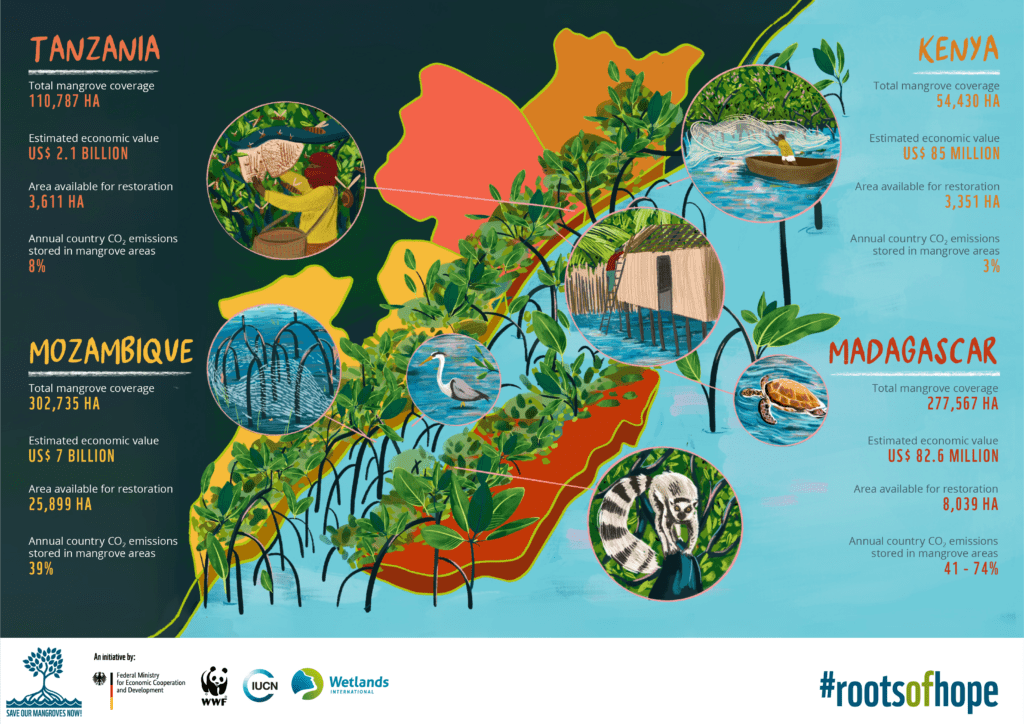Saving our Mangroves in Kenya, Tanzania, Mozambique and Madagascar
Where do we stand?
Mangrove forests are some of the most complex and awe-inducing ecosystems in the world. Arising in the intertidal zone between land and sea, these miraculous forests grow in challenging conditions. The trees take root in soils that are waterlogged and oxygen-poor, alternately submerged and exposed to the air as the tide rises and falls. In these seemingly impossible circumstances, they not only survive but thrive. And in turn, they help us thrive too.
About 5% of the 14.5 million hectares of mangroves worldwide are located in the Western Indian Ocean (WIO) region. Within that region, 99% of mangroves – some 745,518 ha – are found in Kenya, Madagascar, Mozambique and Tanzania. Mangrove forests provide immense value to the coastal communities within these countries. In addition to being a source of food – providing nurseries and habitat for fish and crustaceans amongst a wealth of other species – mangroves maintain the livelihoods of hundreds of thousands of people across the region, supporting industries such as fishing, beekeeping and tourism. The unmatched high density of mangrove wood is often relied on for fuel and for construction materials. In addition, mangroves perform essential ecosystem services such as water filtration, nutrient cycling, carbon sequestration, and shoreline protection – acting as a buffer for storms by trapping sediment and dissipating waves.
 “Mangroves are superheroes, a triple dividend of resilience, biodiversity gain and people. Protecting and conserving them is essential for achieving multiple goals and targets towards the 2050 vision for biodiversity. They are our roots of hope – it is time that their importance is widely recognised.”
“Mangroves are superheroes, a triple dividend of resilience, biodiversity gain and people. Protecting and conserving them is essential for achieving multiple goals and targets towards the 2050 vision for biodiversity. They are our roots of hope – it is time that their importance is widely recognised.”Minna Epps, Head of IUCN Ocean Team Centre of Conservation Action

This report offers an overview of the work by the Save our Mangroves Now! (SOMN) initiative in the region to date, bringing together data on extent, loss and gains, and the socio-economic
value of mangroves in the region, as well as governance challenges and policy opportunities. We hope this will support national efforts and inform the development of a regional mangrove action plan in the Western Indian Ocean region, enabling coordinated and collective action on mangrove conservation and restoration. In addition, we created the guiding principles on sustainable mangrove ecosystem management and aspire for them to guide the design of collective action at the national and regional level in the Western Indian Ocean region and beyond.
We find ourselves at a critical moment in the global effort to secure a healthy and prosperous future for people and nature, as countries around the world – including those spotlighted in this report – come together to take stock of their national efforts towards the global agreement on limiting global warming and adopting a global action plan for restoring nature by 2030. Now more than ever, it is essential that actors at all levels – from local to regional to international – pool knowledge and resources in order to reach our collective goals. We are
encouraged to witness the leadership of the Western Indian Ocean region to protect these precious ecosystems that sustain life in myriad ways, and we hope it will inspire other regions to unite under a shared vision to protect and restore mangroves: our #RootsofHope.